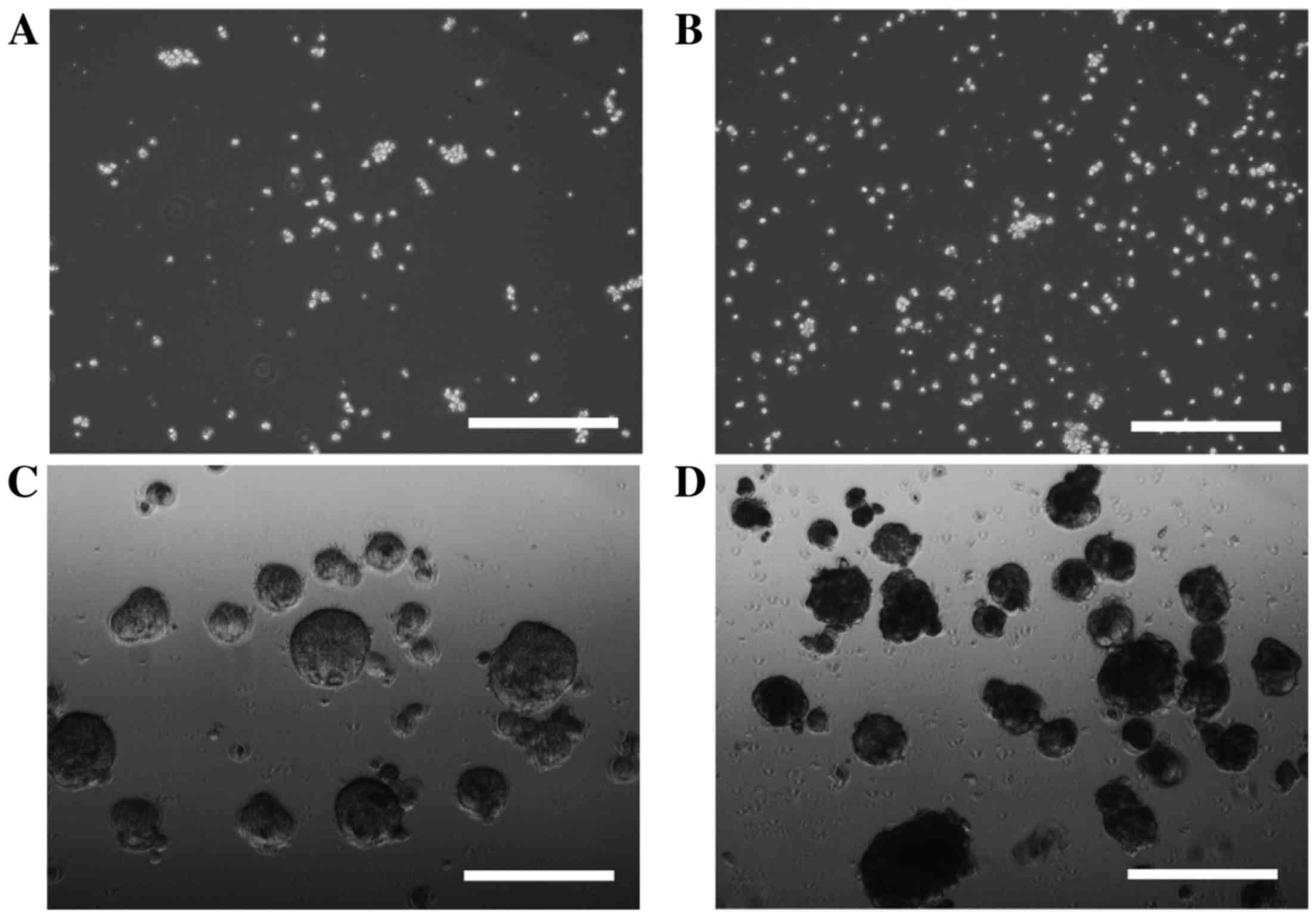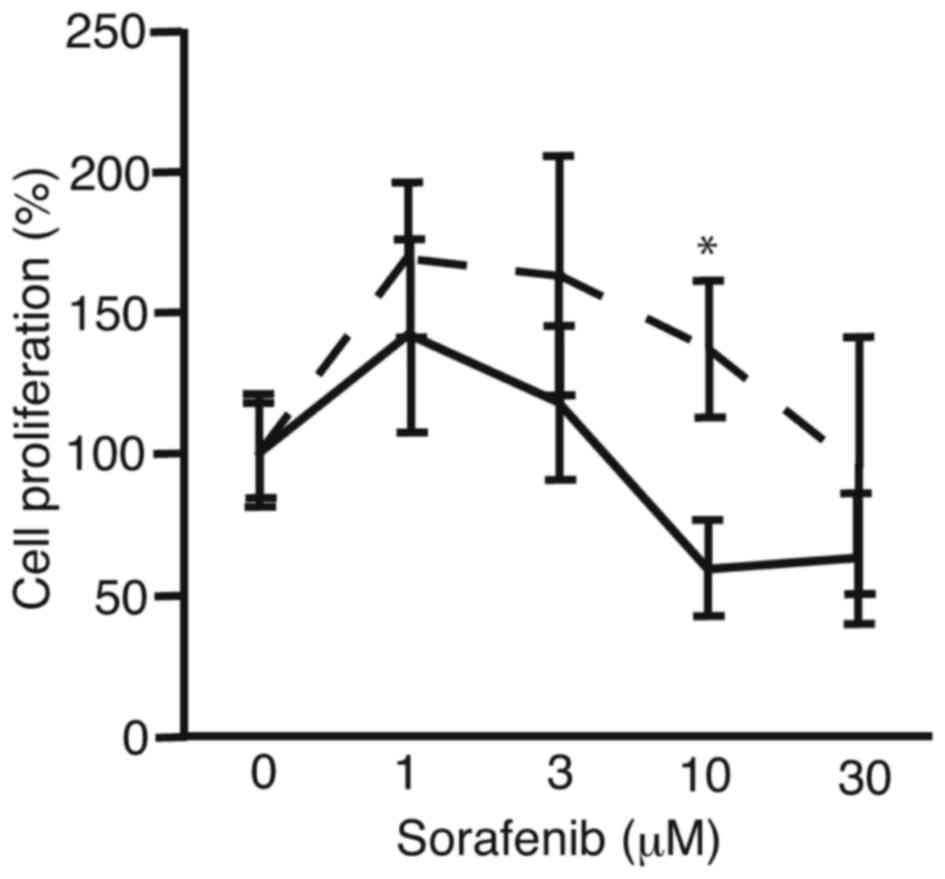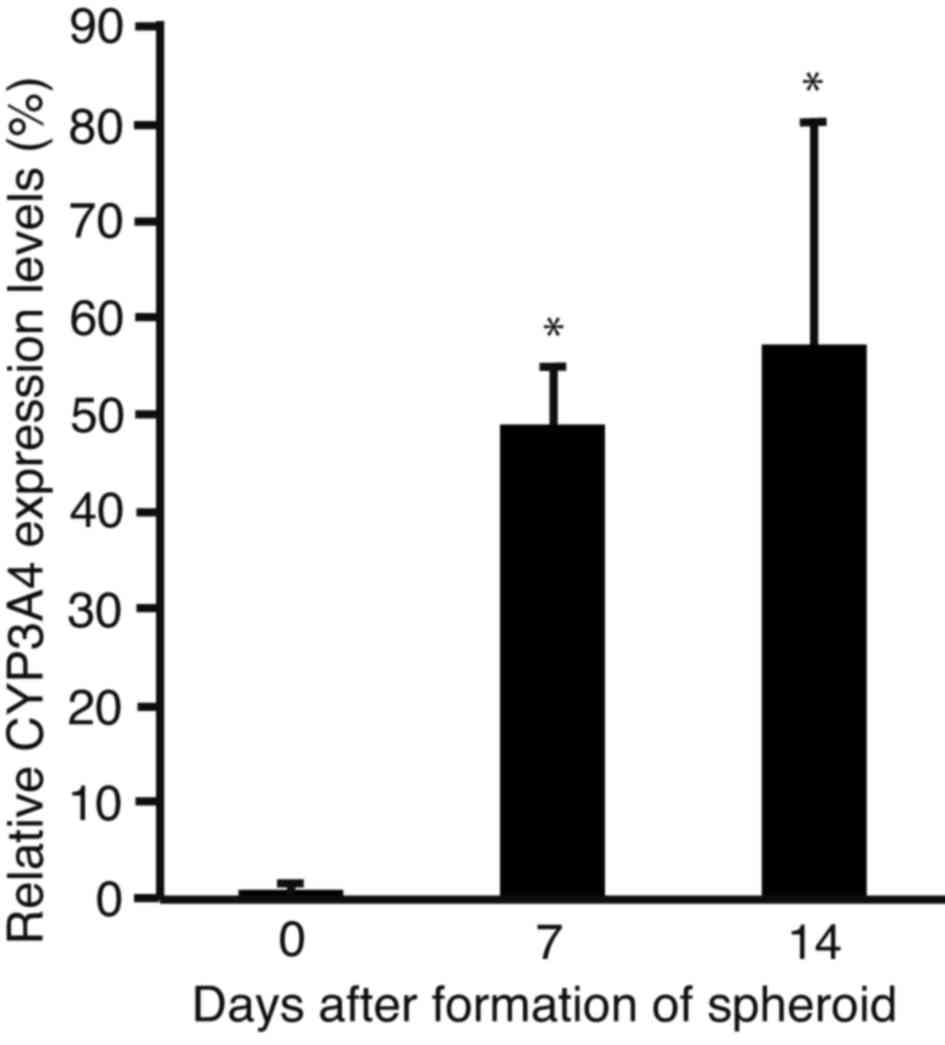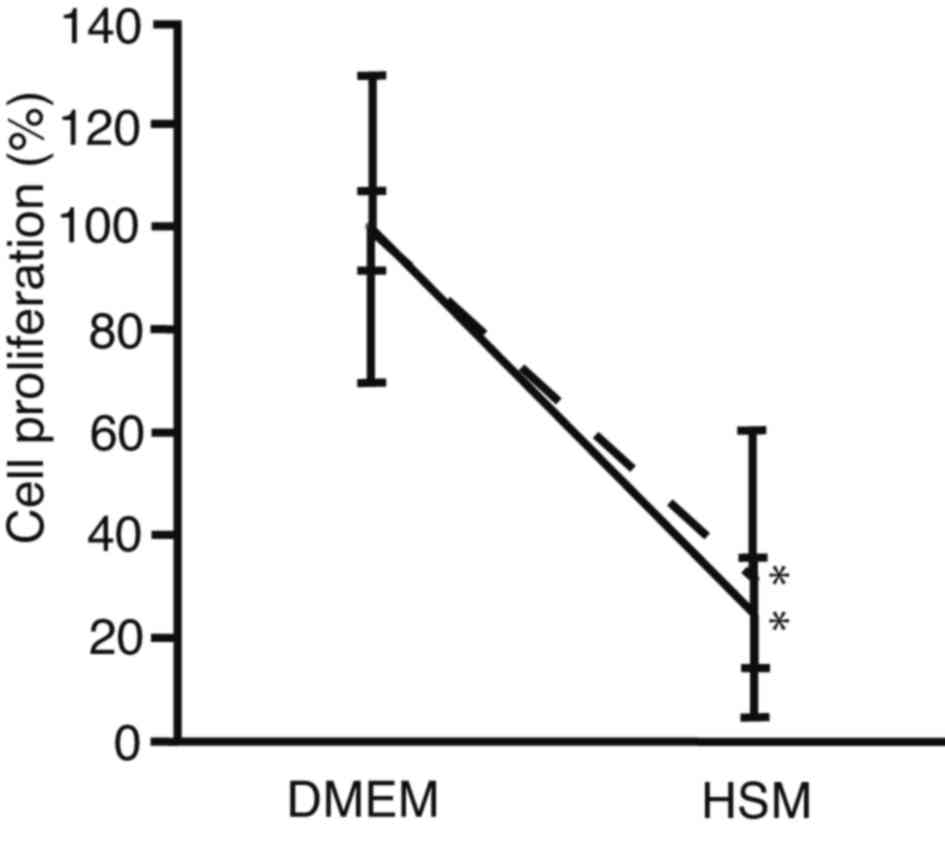Proliferation of sphere‑forming hepatocellular carcinoma cells is suppressed in a medium without glucose and arginine, but with galactose and ornithine
- Authors:
- Published online on: January 2, 2017 https://doi.org/10.3892/ol.2017.5565
- Pages: 1264-1268
Abstract
Introduction
Hepatocellular carcinoma (HCC) is a common cancer of the liver with a typically poor prognosis (1). The current treatment for HCC involves local ablation, surgical resection, transcatheter arterial chemoembolization and systemic administration of chemotherapeutic agents (2,3). Molecular therapy with sorafenib has also previously been established as a viable therapeutic option for HCC (4). Sorafenib is a multikinase inhibitor with a high antitumor efficacy that suppresses cell proliferation and induces apoptosis in HCC cell lines (5–7). A limitation of this approach is that HCC cells acquire resistance to sorafenib (8,9), as it is metabolized by cytochrome P450 (CYP3A4) (10). This has necessitated the development of alternative therapies for HCC.
Cancer cells have increased glycolysis levels, requiring more glucose under insufficient oxygen supply (Warburg effect), compared with surrounding normal tissues (11). Glucose is essential for cell survival (12,13). Galactose is metabolized to galactose-1-phosphate with galactokinase, and enters the glycolysis cycle (14). Arginine is an essential amino acid that is produced from ornithine by ornithine carbamoyltransferase in the urea cycle (15). Normal hepatocytes express galactokinase and ornithine carbamoyltransferase (16,17). Normal hepatocytes are expected to survive in a medium lacking glucose and arginine but supplemented with galactose and ornithine (18,19). In our previous study, a hepatocyte selection medium (HSM) was developed, which lacks glucose and arginine but contains galactose and ornithine (20). Primary human hepatocytes are able to survive in HSM; thus, this medium selects primary human hepatocytes from a co-culture with human-induced pluripotent stem cells (21).
Cancer stem cells are characterized as self-renewing, proliferative, tumorigenic (exhibiting stemness) and chemoresistant (22). The sphere formation assay was previously reported to enrich undifferentiated neural precursor cells (23,24); however, several types of human cancer cells have been demonstrated to form spheres (25,26). HCC cells (PLC/PRF/5 cells), human breast cancer cells (MCF7 cells), glioma cells (U87) and non-small lung cancer cells (A549) form spheres when cultured in serum-free conditions supplemented with epidermal growth factor, at a density of 1×103 cells/ml. Notably, the expression levels of certain stem cell markers increase, including Oct3/4, CD133, and CD44 (26). These reports suggest that cancer cells with stem cell character are enriched in a sphere formation assay.
In the present study, HCC cells were cultured for a sphere formation assay to obtain stem cell character in HCC cells. The resultant cells were cultured in HSM to investigate the potential application to treatment of HCC cells with stem cell character.
Materials and methods
Cell culture
HLF and PLC/PRF/5 human HCC cells were purchased from the Riken Cell Bank (RIKEN BioResource Center, Tsukuba, Japan). HLF cells and PLC/PRF/5 cells were cultured in Dulbecco's modified Eagle's medium (DMEM; Sigma-Aldrich; Merck Millipore, Darmstadt, Germany) supplemented with 10% fetal bovine serum (FBS; Thermo Fisher Scientific, Inc., Waltham, MA, USA). The cell lines were cultured in 10-cm dishes (Asahi Techno Glass; Funabashi, Japan) with 5% CO2 at 37°C in a humidified chamber.
Sphere formation assay
HLF and PLC/PRF/5 cells were trypsinized and cultured in DMEM-F12 (Sigma-Aldrich; Merck Millipore) supplemented with epidermal growth factor (Wako Pure Chemical Industries, Ltd., Osaka, Japan) at 20 ng/ml, basic fibroblast growth factor (Wako Pure Chemical Industries, Ltd.) at 20 ng/ml, 1% B27 supplement (Thermo Fisher Scientific, Inc.) and 1% methylcellulose 25 (Wako Pure Chemical Industries, Ltd.) in Ultra-Low Attachment 6-well plates (Corning Incorporated, Corning, NY, USA). The cells were imaged under a microscope (Olympus Corporation, Tokyo, Japan) after 7 and 14 days of incubation.
Preparation of HSM
HSM was prepared from amino acid powders using the formulation of Leibovitz L-15 medium (Thermo Fisher Scientific, Inc.), omitting arginine, tyrosine, glucose and sodium pyruvate, but adding galactose (900 mg/l; Wako Pure Chemical Industries, Ltd.), ornithine (1 mM; Wako Pure Chemical Industries, Ltd.), glycerol (5 mM; Wako Pure Chemical Industries, Ltd.) and proline (260 mM; Wako Pure Chemical Industries, Ltd.). Proline (30 mg/l) was included in the medium as it is necessary for DNA synthesis (27). Knockout serum replacement (Thermo Fisher Scientific, Inc.) at a final concentration of 10% was used in place of FBS to establish xeno-free conditions. PRL/PRF/5 cells were subjected to a sphere formation assay. The spheres were transferred to a tube, trypsinized, and seeded onto 96-well flat-bottom plates (Asahi Techno Glass) at the density of 1,000 cells/well. After a 24-h culture in DMEM, HSM was applied, and subjected to a cell proliferation assay. PRL/PRF/5 cells cultured in DMEM in conventional 6-well plates (Asahi Techno Glass) were used as a control.
Application of sorafenib
PRL/PRF/5 cells were analyzed to determine whether cell proliferation was suppressed by sorafenib. Following sphere formation, the cells were seeded to 96-well flat-bottom plates at a density of 1,000 cells/well and incubated for 24 h in DMEM supplemented with 10% FBS. Sorafenib (JS Research Chemicals Trading e.Kfm, Wedel, Germany) was added to the media at concentrations of 0, 1, 3, 10 and 30 µM. PRL/PRF/5 cells cultured in DMEM in conventional 6-well plates (Asahi Techno Glass) were used as a control.
Cell proliferation analysis
The cells were cultured for 72 h and subjected to an MTS assay (Promega Corporation, Madison, WI, USA) according to the manufacturer's instructions. The cells reduce MTS to a colored formazan product that has a maximum absorbance at 490 nm. The absorbance was measured using an iMark Microplate Absorbance Reader (Bio-Rad Laboratories, Inc., Hercules, CA, USA).
Reverse transcription-quantitative polymerase chain reaction (RT-qPCR)
Total RNA (5 mg) was isolated using Isogen (Nippon Gene, Co, Ltd., Tokyo, Japan) and used for the first-strand cDNA synthesis with SuperScript III and oligo-dT (Thermo Fisher Scientific, Inc.), according to the manufacturer's instructions. RT-qPCR was performed with Fast SYBR Green Master Mix (Thermo Fisher Scientific, Inc.), and the results were analyzed using the MiniOpticon system (Bio-Rad Laboratories, Inc.). RT-qPCR was performed for a total of 40 cycles, with 5 sec of denaturation and 5 sec of annealing-extension. The RT-qPCR primer pairs for ribosomal protein L19 (RPL19) and CYP3A4 were 5′-CGAATGCCAGAGAAGGTCAC-3′ (forward) and 5′-CCATGAGAATCCGCTTGTTT-3′ (reverse) (GenBank, BC000530; expected product size, 157 bp), 5′-TGAGAAATCTGAGGCGGGAAGC-3′ (forward) and 5′-CGATGTTCACTCCAAATGATGTGC-3′ (reverse) (GenBank, J04449; expected product size, 111 bp), respectively. RPL19 was used as an internal control, as the target gene was a constitutively expressed housekeeping gene (28). The primer sequences were obtained with MacVector 14.0.6 (MacVector Inc., Apex, NC, USA).
Statistical analysis
The data were presented as the mean ± standard deviation. The data were analyzed by one-way analysis of variance using JMP 10.0.2 software (SAS Institute, Cary, NC, USA). P<0.05 was considered to indicate a statistically significant result.
Results
Sphere formation
In order to investigate cell sphere formation, HLF cells and PLC/PRF/5 cells were cultured for sphere formation for 7 or 14 days. HLF cells did not form spheres after 7 days (Fig. 1A) or 14 days (Fig. 1B) of incubation; however, sphere formation was observed in PLC/PRF/5 cells after 7 days (Fig. 1C) and 14 days (Fig. 1D) of incubation. PRL/PRF/5 cells were used for further investigation.
Sorafenib
In order to analyze the suppression of proliferation of PRL/PRF/5 cells after sphere formation, the cells were subjected to cell proliferation assay (Fig. 2). PRL/PRF/5 cells cultured in conventional 6-well plates were used for control. There was a tendency for sorafenib to be more tolerated by the PRL/PRF/5 cells following sphere formation than the control cells. At 10 µM, cell proliferation of sphere-formed cells and control cells were 137±24 and 59±17%, respectively (P<0.0036). The results suggest the PLC/PRF/5 cells that form spheres are more resistant to sorafenib compared with cells cultured in 6-well plates, which did not form spheres.
Expression levels of CYP3A4
In order to analyze changes in the expression levels of CYP3A4, the sphere-forming PLC/PRF/5 cells were subjected to RT-qPCR (Fig. 3). The expression levels of CYP3A4 were significantly increased after 7 (P<0.0001) and 14 days (P<0.001) of incubation, as compared with day 0.
Suppression of cell proliferation with HSM
In order to compare the suppression of cell proliferation cells between after sphere formation and conventional culture, PRL/PRF/5 cells were seeded onto 96-well plates. The medium was changed to HSM, and subjected to cell proliferation assay after 72 h culture (Fig. 4). For cells cultured using a conventional method, cell proliferation decreased to 25±11% in HSM, as compared with DMEM (P<0.0001). For cells analyzed following sphere formation, it was observed that cell proliferation decreased to 32±28% in HSM, as compared with DMEM (P=0.0011). There was no statistically significant difference in cell proliferation between cells analyzed following sphere formation and those cultured in HSM (P=0.7100). These results suggest that HSM suppressed cell proliferation of PRL/PRF/5 cells following sphere formation at the same levels as conventional culture. The HSM created in the present study, which did not contain glucose or arginine, was demonstrated to suppress proliferation equally in PLC/PRF/5 cell spheres and in control cells.
Discussion
PLC/PRF/5 cell spheres exhibit stemness and resistance to fluorouracil, mitomycin C, and sorafenib (26). In the present study, sphere-forming PLC/PRF/5 cells were seeded onto 96-well plates to evaluate their sensitivity to sorafenib using a proliferation assay. Suppression of cell proliferation with sorafenib was decreased in the cells following sphere formation, as compared with control cells. These results were consistent with those of a previous report (26). The previous results and the data of the present study demonstrated that PLC/PRF/5 cells were more resistance to sorafenib due to their stemness following sphere formation. The mechanism of resistance was subsequently investigated.
Sorafenib is metabolized by CYP3A4 (10). In the present study, the expression levels of CYP3A4 were observed to increase during sphere formation. The results indicate that PLC/PRF/5 cells acquired resistance to sorafenib due to the increased expression levels of CYP3A4. Patient survival would be poor with cancer stem cells due to the resistance to chemotherapeutic agents, such as sorafenib (29). Cancer stem cells are, therefore, one of the targets of treatment (30).
Cancer cells require more glucose than normal cells due to the Warburg effect (11). Therefore, glucose metabolism is a potential therapeutic target for the treatment of HCC. The results suggest that the sphere-forming PLC/PRF/5 cells did not acquire resistance to glucose deprivation. Glucose metabolism, therefore, represents a potential target for the treatment of HCC, with a low risk of acquired resistance.
2-Deoxyglucose (2DG) is an analog of glucose that recapitulates the effect of glucose-deprivation on cancer cells (31). The anticancer effects of 2DG have been reported as limited (32); however, the administration of 2DG in combination with other anticancer agents may be a potentially effective strategy for the treatment of certain types of cancer, including HCC. The results suggest that the deprivation of glucose and arginine may be an effective approach for the treatment of HCC. Furthermore, the efficacy of arginase, which metabolizes arginine, has been previously demonstrated in HCC (33). The combination of 2DG and arginase must be investigated in further studies as a potential strategy for the treatment of HCC.
In conclusion, PLC/PRF/5 cells acquired resistance to sorafenib following sphere formation, suggesting stemness. Cell proliferation of PRL/PRF/5 cells was suppressed with HSM. Therefore, the deprivation of glucose and arginine may serve as an effective potential treatment for HCC.
References
|
Trojan J, Zangos S and Schnitzbauer AA: Diagnostics and treatment of hepatocellular carcinoma in 2016: Standards and developments. Visc Med. 32:116–120. 2016.PubMed/NCBI | |
|
Lencioni R, Petruzzi P and Crocetti L: Chemoembolization of hepatocellular carcinoma. Semin Intervent Radiol. 30:3–11. 2013. View Article : Google Scholar : PubMed/NCBI | |
|
Kim HY and Park JW: Clinical trials of combined molecular targeted therapy and locoregional therapy in hepatocellular carcinoma: Past, present, and future. Liver Cancer. 3:9–17. 2014. View Article : Google Scholar : PubMed/NCBI | |
|
Furuse J, Ishii H, Nakachi K, Suzuki E, Shimizu S and Nakajima K: Phase I study of sorafenib in Japanese patients with hepatocellular carcinoma. Cancer Sci. 99:159–165. 2008.PubMed/NCBI | |
|
Wilhelm SM, Carter C, Tang L, Wilkie D, McNabola A, Rong H, Chen C, Zhang X, Vincent P, McHugh M, et al: BAY 43–9006 exhibits broad spectrum oral antitumor activity and targets the RAF/MEK/ERK pathway and receptor tyrosine kinases involved in tumor progression and angiogenesis. Cancer Res. 64:7099–7109. 2004. View Article : Google Scholar : PubMed/NCBI | |
|
Liu L, Cao Y, Chen C, Zhang X, McNabola A, Wilkie D, Wilhelm S, Lynch M and Carter C: Sorafenib blocks the RAF/MEK/ERK pathway, inhibits tumor angiogenesis, and induces tumor cell apoptosis in hepatocellular carcinoma model PLC/PRF/5. Cancer Res. 66:11851–11858. 2006. View Article : Google Scholar : PubMed/NCBI | |
|
Tomizawa M, Shinozaki F, Sugiyama T, Yamamoto S, Sueishi M and Yoshida T: Sorafenib suppresses the cell cycle and induces the apoptosis of hepatocellular carcinoma cell lines in serum-free media. Exp Ther Med. 1:863–866. 2010. View Article : Google Scholar : PubMed/NCBI | |
|
Okuyama H, Ikeda M, Kuwahara A, Takahashi H, Ohno I, Shimizu S, Mitsunaga S, Senda S and Okusaka T: Prognostic factors in patients with hepatocellular carcinoma refractory or intolerant to sorafenib. Oncology. 88:241–246. 2015. View Article : Google Scholar : PubMed/NCBI | |
|
Chen J, Jin R, Zhao J, Liu J, Ying H, Yan H, Zhou S, Liang Y, Huang D, Liang X, et al: Potential molecular, cellular and microenvironmental mechanism of sorafenib resistance in hepatocellular carcinoma. Cancer Lett. 367:1–11. 2015. View Article : Google Scholar : PubMed/NCBI | |
|
Ye L, Yang X, Guo E, Chen W, Lu L, Wang Y, Peng X, Yan T, Zhou F and Liu Z: Sorafenib metabolism is significantly altered in the liver tumor tissue of hepatocellular carcinoma patient. PLoS One. 9:e966642014. View Article : Google Scholar : PubMed/NCBI | |
|
Vaitheesvaran B, Xu J, Yee J, Q-Y L, Go VL, Xiao GG and Lee WN: The Warburg effect: A balance of flux analysis. Metabolomics. 11:787–796. 2015. View Article : Google Scholar : PubMed/NCBI | |
|
Leffert HL and Paul D: Studies on primary cultures of differentiated fetal liver cells. J Cell Biol. 52:559–568. 1972. View Article : Google Scholar : PubMed/NCBI | |
|
Matsumoto K, Yamada K, Kohmura E, Kinoshita A and Hayakawa T: Role of pyruvate in ischaemia-like conditions on cultured neurons. Neurol Res. 16:460–464. 1994. View Article : Google Scholar : PubMed/NCBI | |
|
Holden HM, Thoden JB, Timson DJ and Reece RJ: Galactokinase: Structure, function and role in type II galactosemia. Cell Mol Life Sci. 61:2471–2484. 2004. View Article : Google Scholar : PubMed/NCBI | |
|
Wheatley DN, Scott L, Lamb J and Smith S: Single amino acid (arginine) restriction: Growth and death of cultured HeLa and human diploid fibroblasts. Cell Physiol Biochem. 10:37–55. 2000. View Article : Google Scholar : PubMed/NCBI | |
|
Ohira RH, Dipple KM, Zhang YH and McCabe ER: Human and murine glycerol kinase: Influence of exon 18 alternative splicing on function. Biochem Biophys Res Commun. 331:239–246. 2005. View Article : Google Scholar : PubMed/NCBI | |
|
Ai Y, Jenkins NA, Copeland NG, Gilbert DH, Bergsma DJ and Stambolian D: Mouse galactokinase: Isolation, characterization, and location on chromosome 11. Genome Res. 5:53–59. 1995. View Article : Google Scholar : PubMed/NCBI | |
|
Phillips JW, Jones ME and Berry MN: Implications of the simultaneous occurrence of hepatic glycolysis from glucose and gluconeogenesis from glycerol. Eur J Biochem. 269:792–797. 2002. View Article : Google Scholar : PubMed/NCBI | |
|
Sumida KD, Crandall SC, Chadha PL and Qureshi T: Hepatic gluconeogenic capacity from various precursors in young versus old rats. Metabolism. 51:876–880. 2002. View Article : Google Scholar : PubMed/NCBI | |
|
Tomizawa M, Toyama Y, Ito C, Toshimori K, Iwase K, Takiguchi M, Saisho H and Yokosuka O: Hepatoblast-like cells enriched from mouse embryonic stem cells in medium without glucose, pyruvate, arginine, and tyrosine. Cell Tissue Res. 333:17–27. 2008. View Article : Google Scholar : PubMed/NCBI | |
|
Tomizawa M, Shinozaki F, Sugiyama T, Yamamoto S, Sueishi M and Yoshida T: Survival of primary human hepatocytes and death of induced pluripotent stem cells in media lacking glucose and arginine. PLoS One. 8:e718972013. View Article : Google Scholar : PubMed/NCBI | |
|
Ma S, Chan KW, Hu L, Lee TK, Wo JY, Ng IO, Zheng BJ and Guan XY: Identification and characterization of tumorigenic liver cancer stem/progenitor cells. Gastroenterology. 132:2542–2556. 2007. View Article : Google Scholar : PubMed/NCBI | |
|
Reynolds BA and Weiss S: Clonal and population analyses demonstrate that an EGF-responsive mammalian embryonic CNS precursor is a stem cell. Dev Biol. 175:1–13. 1996. View Article : Google Scholar : PubMed/NCBI | |
|
Rappa G, Mercapide J, Anzanello F, Prasmickaite L, Xi Y, Ju J, Fodstad O and Lorico A: Growth of cancer cell lines under stem cell-like conditions has the potential to unveil therapeutic targets. Exp Cell Res. 314:2110–2122. 2008. View Article : Google Scholar : PubMed/NCBI | |
|
Kim J, Jung J, Lee SJ, Lee JS and Park MJ: Cancer stem-like cells persist in established cell lines through autocrine activation of EGFR signaling. Oncol Lett. 3:607–612. 2012.PubMed/NCBI | |
|
Cao L, Zhou Y, Zhai B, Liao J, Xu W, Zhang R, Li J, Zhang Y, Chen L, Qian H, et al: Sphere-forming cell subpopulations with cancer stem cell properties in human hepatoma cell lines. BMC Gastroenterol. 11:712011. View Article : Google Scholar : PubMed/NCBI | |
|
Nakamura T, Teramoto H, Tomita Y and Ichihara A: L-proline is an essential amino acid for hepatocyte growth in culture. Biochem Biophys Res Commun. 122:884–891. 1984. View Article : Google Scholar : PubMed/NCBI | |
|
Davies B and Fried M: The L19 ribosomal protein gene (RPL19): Gene organization, chromosomal mapping, and novel promoter region. Genomics. 25:372–380. 1995. View Article : Google Scholar : PubMed/NCBI | |
|
Olszewski U, Liedauer R, Ausch C, Thalhammer T and Hamilton G: Overexpression of CYP3A4 in a COLO 205 Colon Cancer Stem Cell Model in vitro. Cancers (Basel). 3:1467–1479. 2011. View Article : Google Scholar : PubMed/NCBI | |
|
Pang RW and Poon RT: Cancer stem cell as a potential therapeutic target in hepatocellular carcinoma. Curr Cancer Drug Targets. 12:1081–1094. 2012. View Article : Google Scholar : PubMed/NCBI | |
|
Simons AL, Mattson DM, Dornfeld K and Spitz DR: Glucose deprivation-induced metabolic oxidative stress and cancer therapy. J Cancer Res Ther. 5:(Suppl 1). S2–S6. 2009. View Article : Google Scholar : PubMed/NCBI | |
|
Zhang D, Li J, Wang F, Hu J, Wang S and Sun Y: 2-Deoxy-D-glucose targeting of glucose metabolism in cancer cells as a potential therapy. Cancer Lett. 355:176–183. 2014. View Article : Google Scholar : PubMed/NCBI | |
|
Phillips MM, Sheaff MT and Szlosarek PW: Targeting arginine-dependent cancers with arginine-degrading enzymes: Opportunities and challenges. Cancer Res Treat. 45:251–262. 2013. View Article : Google Scholar : PubMed/NCBI |













